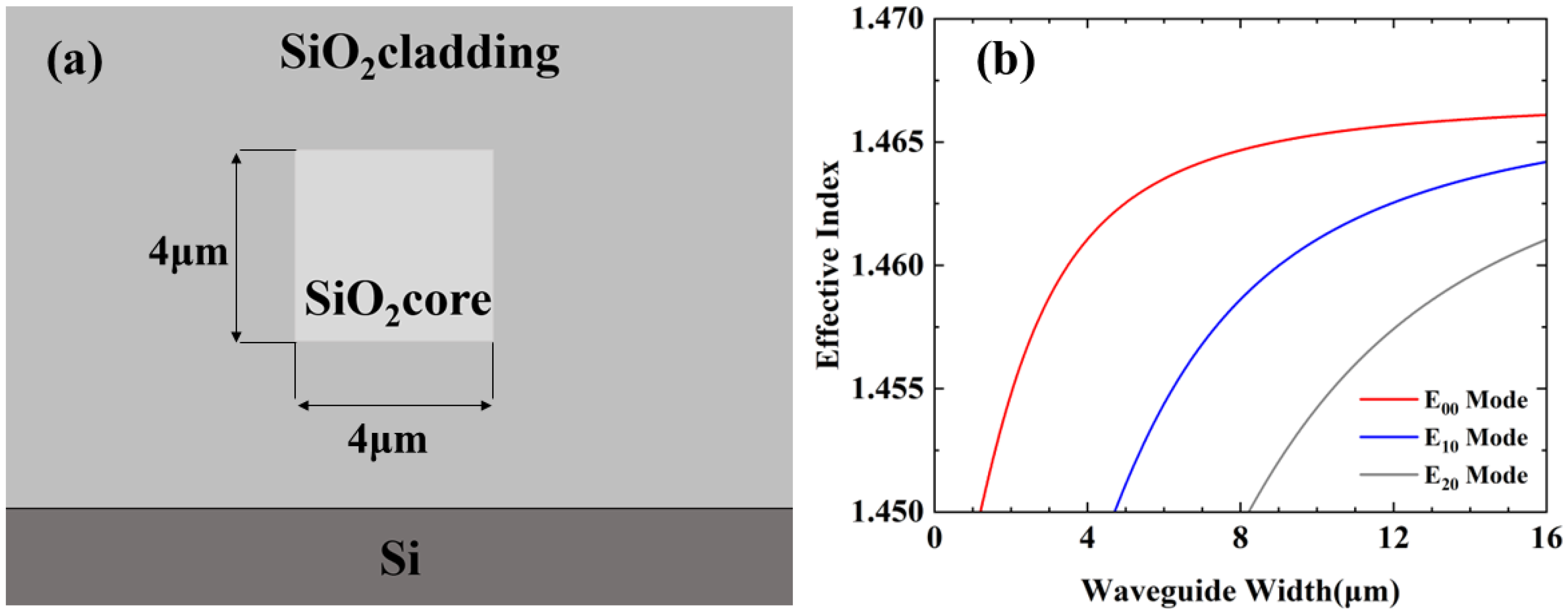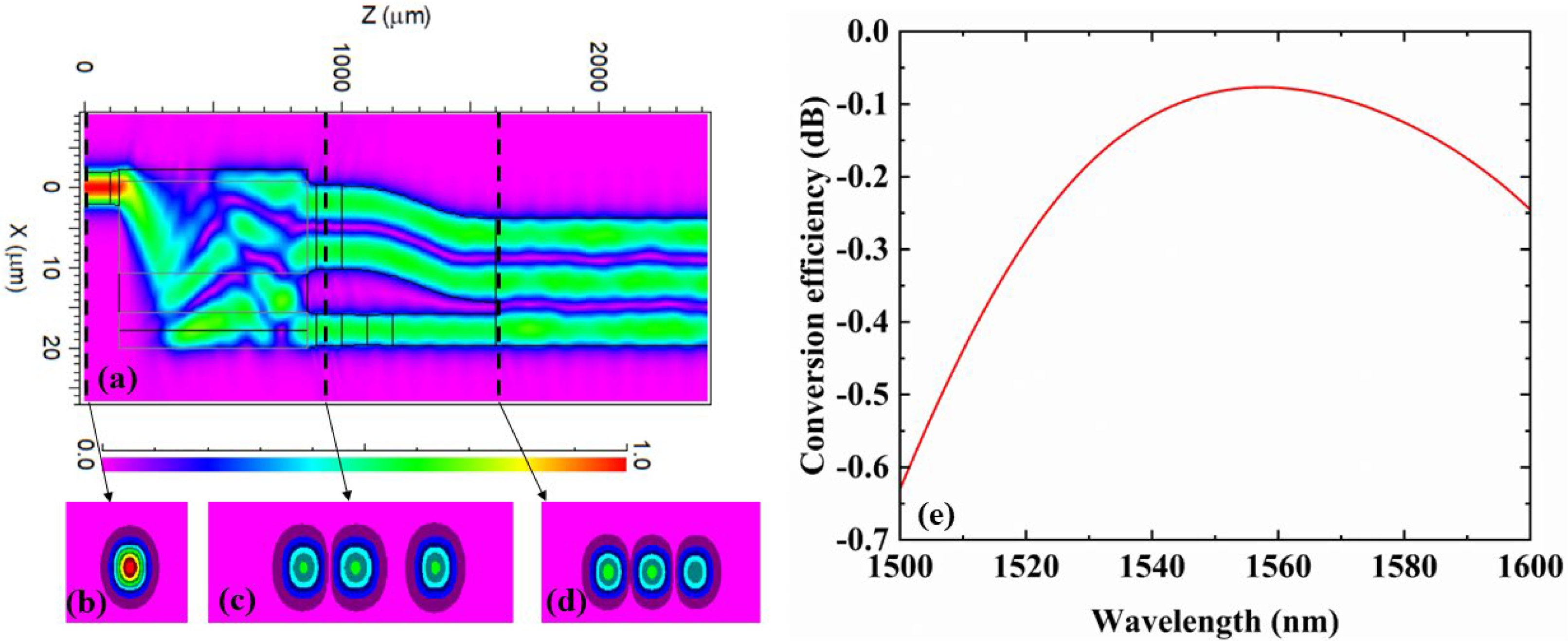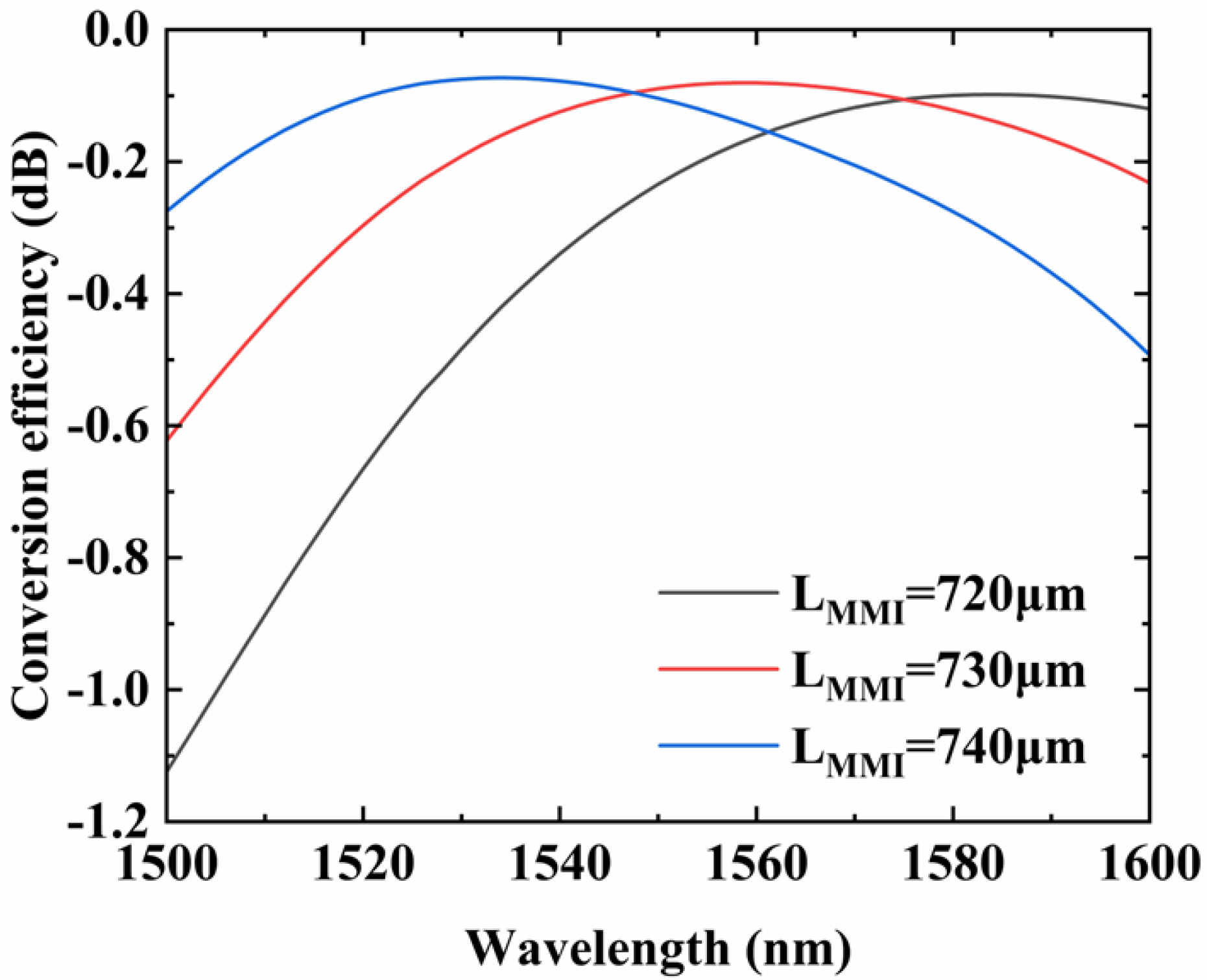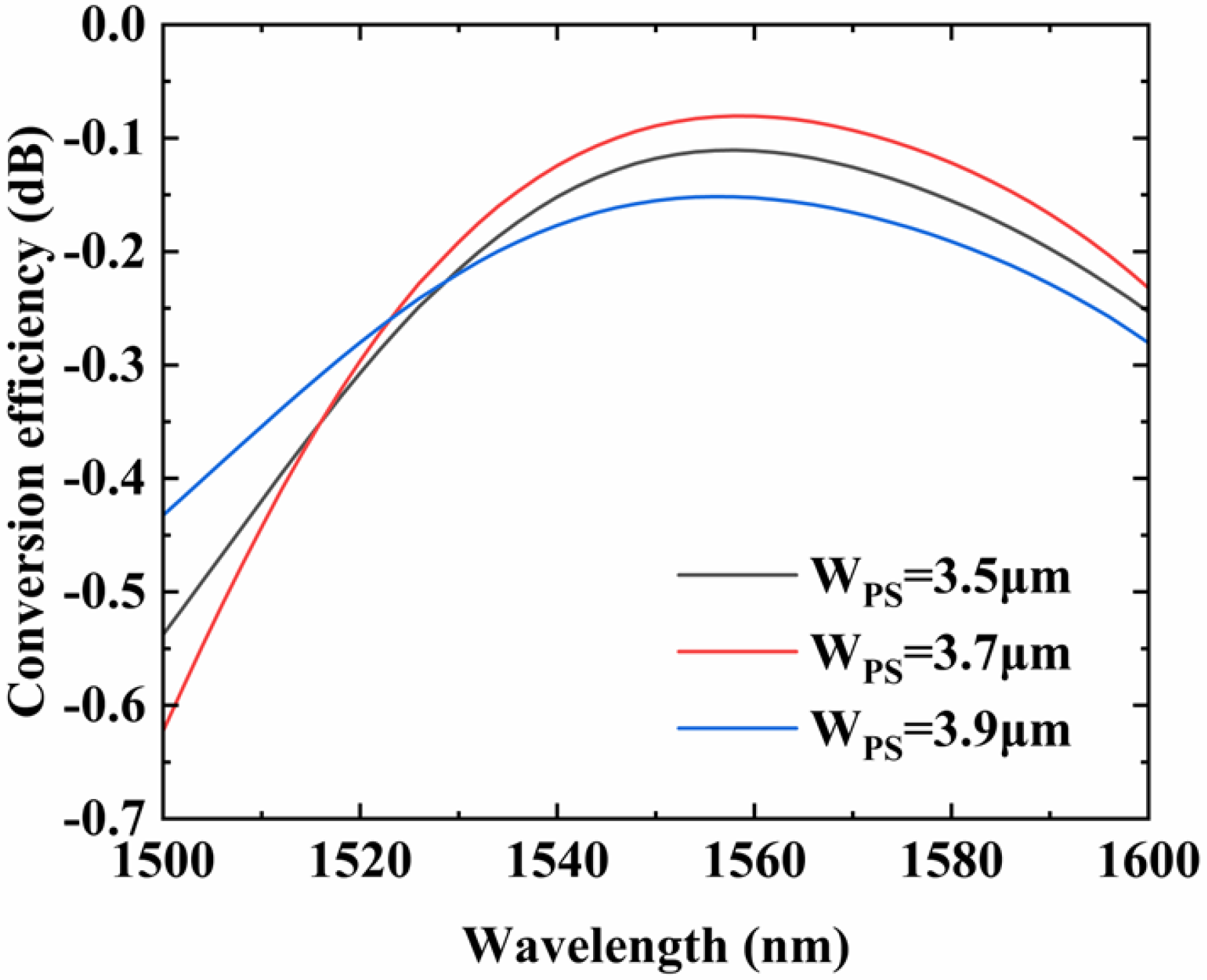On-Chip E00–E20 Mode Converter Based on Multi-Mode Interferometer
Abstract
1. Introduction
2. Design and Simulation
3. Characterization and Discussion
4. Discussion
5. Conclusions
Author Contributions
Funding
Data Availability Statement
Conflicts of Interest
References
- Winter, M.; Setti, D.; Petermann, K. Cross-Polarization Modulation in Polarization-Division Multiplex Transmission. IEEE Photonics Technol. Lett. 2010, 22, 538–540. [Google Scholar] [CrossRef]
- Chun, H.; Rajbhandari, S.; Faulkner, G.; Tsonev, D.; Xie, E.; McKendry, J.J.D.; Gu, E.; Dawson, M.D.; O’Brien, D.C.; Haas, H. LED Based Wavelength Division Multiplexed 10 Gb/s Visible Light Communications. J. Light. Technol. 2016, 34, 3047–3052. [Google Scholar] [CrossRef]
- Mizuno, T.; Takara, H.; Sano, A.; Miyamoto, Y. Dense Space-Division Multiplexed Transmission Systems Using Multi-Core and Multi-Mode Fiber. J. Light. Technol. 2016, 34, 582–592. [Google Scholar] [CrossRef]
- Goossens, J.W.; Yousefi, M.I.; Jaouen, Y.; Hafermann, H. Polarization-division multiplexing based on the nonlinear Fourier transform. Opt. Express 2017, 25, 26437–26452. [Google Scholar] [CrossRef]
- Zhang, Y.; Pan, S. Photonics-based multi-function analog signal processor based on a polarization division multiplexing Mach-Zehnder modulator. Opt. Lett. 2017, 42, 5034–5037. [Google Scholar] [CrossRef]
- Gao, Y.; Xu, Y.; Ji, L.; Sun, X.; Wang, F.; Wang, X.; Wu, Y.; Zhang, D. Scalable compact mode (de)multiplexer based on asymmetric Y-junctions. Opt. Commun. 2019, 438, 34–38. [Google Scholar] [CrossRef]
- Han, X.; Xiao, H.; Liu, Z.; Zhao, T.; Jia, H.; Yang, J.; Eggleton, B.J.; Tian, Y. Reconfigurable On-Chip Mode Exchange for Mode-Division Multiplexing Optical Networks. J. Light. Technol. 2019, 37, 1008–1013. [Google Scholar] [CrossRef]
- Yang, Y.; Liu, J.; Cheng, R.; Jia, J.; Gao, Y.; Shen, L.; Chen, Z.; He, Y.; Li, J. SDM-WDM ROADM Based on Direct-Laser-Writing SDM Core Separator. IEEE Photonics J. 2022, 14, 7230506. [Google Scholar] [CrossRef]
- Memon, A.K.; Chen, K.X. Recent advances in mode converters for a mode division multiplex transmission system. Opto-Electron. Rev. 2023, 29, 13–32. [Google Scholar] [CrossRef]
- Sun, S.; Che, Y.; Zhu, M.; Lian, T.; Sun, X.; Wang, X.; Huang, Q.; Zhang, D. Mode-insensitive 3-dB power splitter based on multimode-interference coupler. Opt. Laser Technol. 2023, 159, 109017. [Google Scholar] [CrossRef]
- Ye, M.; Yu, Y.; Sun, C.; Zhang, X. On-chip data exchange for mode division multiplexed signals. Opt. Express 2016, 24, 528–535. [Google Scholar] [CrossRef]
- Gao, Y.; Zhang, D.; Xu, Y.; Fan, X.; Wang, F.; Sun, X. Ultra-broadband polymer E00/E10 mode converter. Opt. Commun. 2022, 508, 127715. [Google Scholar] [CrossRef]
- Yu, Y.; Ye, M.; Fu, S. On-Chip Polarization Controlled Mode Converter with Capability of WDM Operation. IEEE Photonics Technol. Lett. 2015, 27, 1957–1960. [Google Scholar] [CrossRef]
- Luo, L.W.; Ophir, N.; Chen, C.P.; Gabrielli, L.H.; Poitras, C.B.; Bergmen, K.; Lipson, M. WDM-compatible mode-division multiplexing on a silicon chip. Nat. Commun. 2014, 5, 3069. [Google Scholar] [CrossRef]
- Frandsen, L.H.; Elesin, Y.; Frellsen, L.F.; Mitrovic, M.; Ding, Y.; Sigmund, O.; Yvind, K. Topology optimized mode conversion in a photonic crystal waveguide fabricated in silicon-on-insulator material. Opt. Express 2014, 22, 8525–8532. [Google Scholar] [CrossRef]
- Deng, Q.; Yan, Q.; Liu, L.; Li, X.; Michel, J.; Zhou, Z. Robust polarization-insensitive strip-slot waveguide mode converter based on symmetric multimode interference. Opt. Express 2016, 24, 7347–7355. [Google Scholar] [CrossRef]
- Ye, W.; Yuan, X.; Gao, Y.; Liu, J. Design of broadband silicon-waveguide mode-order converter and polarization rotator with small footprints. Opt. Express 2017, 25, 33176–33183. [Google Scholar] [CrossRef]
- Wang, H.; Zhang, Y.; He, Y.; Zhu, Q.; Sun, L.; Su, Y. Compact Silicon Waveguide Mode Converter Employing Dielectric Metasurface Structure. Adv. Opt. Mater. 2018, 7, 1801191. [Google Scholar] [CrossRef]
- Chen, R.; Bai, B.; Yang, F.; Zhou, Z. Ultra-compact hybrid plasmonic mode convertor based on unidirectional eigenmode expansion. Opt. Lett. 2020, 45, 803–806. [Google Scholar] [CrossRef]
- Wang, T.; Guo, H.; Chen, H.; Yang, J.; Jia, H. Ultra-compact reflective mode converter based on a silicon subwavelength structure. Appl. Opt. 2020, 59, 2754–2758. [Google Scholar] [CrossRef]
- Sun, Y.; Xiong, Y.; Ye, W.N. Experimental demonstration of a two-mode (de)multiplexer based on a taper-etched directional coupler. Opt. Lett. 2016, 41, 3743–3746. [Google Scholar] [CrossRef] [PubMed]
- Driscoll, J.B.; Grote, R.R.; Souhan, B.; Dadap, J.I.; Lu, M.; Osgood, R.M. Asymmetric Y junctions in silicon waveguides for on-chip mode-division multiplexing. Opt. Lett. 2013, 38, 1854–1856. [Google Scholar] [CrossRef] [PubMed]
- Gao, Y.; Sun, X.; Li, P.; Zhang, D. Polymer Mode Selecting Switch Based on Cascaded MMI Couplers. IEEE Photonics Technol. Lett. 2021, 33, 147–150. [Google Scholar] [CrossRef]
- Ou, X.; Yang, Y.; Tang, B.; Li, D.; Sun, F.; Zhang, P.; Liu, R.; Li, B.; Li, Z. Low-loss silicon nitride strip-slot mode converter based on MMI. Opt. Express 2021, 29, 19049–19057. [Google Scholar] [CrossRef]
- Li, Z.; Kim, M.H.; Wang, C.; Han, Z.; Shrestha, S.; Overvig, A.C.; Lu, M.; Stein, A.; Agarwal, A.M.; Loncar, M.; et al. Controlling propagation and coupling of waveguide modes using phase-gradient metasurfaces. Nat. Nanotechnol. 2017, 12, 675–683. [Google Scholar] [CrossRef]
- Meng, Y.; Liu, Z.; Xie, Z.; Wang, R.; Qi, T.; Hu, F.; Kim, H.; Xiao, Q.; Fu, X.; Wu, Q.; et al. Versatile on-chip light coupling and (de)multiplexing from arbitrary polarizations to controlled waveguide modes using an integrated dielectric metasurface. Photonics Res. 2020, 8, 564–576. [Google Scholar] [CrossRef]
- Zhao, Y.; Guo, X.; Zhang, Y.; Xiang, J.; Wang, K.; Wang, H.; Su, Y. Ultra-compact silicon mode-order converters based on dielectric slots. Opt. Lett. 2020, 45, 3797–3800. [Google Scholar] [CrossRef]
- Meng, Y.; Chen, Y.; Lu, L.; Ding, Y.; Cusano, A.; Fan, J.A.; Hu, Q.; Wang, K.; Xie, Z.; Liu, Z.; et al. Optical meta-waveguides for integrated photonics and beyond. Light Sci. Appl. 2021, 10, 235. [Google Scholar] [CrossRef]
- Jifang, Q.; Daolin, Z.; Ye, T.; Jian, W.; Yan, L.; Yue, W. Performance Analysis of a Broadband Second-Order Mode Converter Based on Multimode Interference Coupler and Phase shifter. IEEE Photonics J. 2015, 7, 1–8. [Google Scholar] [CrossRef]
- Xu, Y.; Gao, Y.; Liu, S.; Liu, T.; Sun, X.; Tang, B.; Zhang, P.; Zhang, D. Wideband E00-E10 Silicon Mode Converter Based on 180 nm CMOS Technology. Appl. Sci. 2022, 12, 10688. [Google Scholar] [CrossRef]
- Linh, H.D.T.; Dung, T.C.; Tanizawa, K.; Thang, D.D.; Hung, N.T. Arbitrary TE0/TE1/TE2/TE3 Mode Converter Using 1 × 4 Y-Junction and 4 × 4 MMI Couplers. IEEE J. Sel. Top. Quantum Electron. 2020, 26, 1–8. [Google Scholar] [CrossRef]
- Chen, Z.; Lin, T.; Liu, X.; Lv, H. Ultra-Compact Broadband In-Line Mode Converter Based on a Width-Modulated Silicon Waveguide. IEEE Photonics J. 2021, 13, 1–7. [Google Scholar] [CrossRef]
- Fei, Y.; Xu, Y.; Huang, D.; Dong, Y.; Zhang, B.; Ni, Y.; Wai, P.K.A. On-Chip Reconfigurable and Ultracompact Silicon Waveguide Mode Converters Based on Nonvolatile Optical Phase Change Materials. Nanomaterials 2022, 12, 4225. [Google Scholar] [CrossRef]
- Wuttig, M.; Bhaskaran, H.; Taubner, T. Phase-change materials for non-volatile photonic applications. Nat. Photonics 2017, 11, 465–476. [Google Scholar] [CrossRef]
- Meng, Y.; Feng, J.; Han, S.; Xu, Z.; Mao, W.; Zhang, T.; Kim, J.S.; Roh, I.; Zhao, Y.; Kim, D.-H.; et al. Photonic van der Waals integration from 2D materials to 3D nanomembranes. Nat. Rev. Mater. 2023. [CrossRef]
- Jin, W.; Chiang, K.S. Mode converters based on cascaded long-period waveguide gratings. Opt. Lett. 2016, 41, 3130–3133. [Google Scholar] [CrossRef]








| Refs. | S/E | BW (nm) | CE (%) | Structure | Materials | Footprint (µm2) |
|---|---|---|---|---|---|---|
| [29] | E | 35 | 93 | MMI+ phase shifter | SOI | 1230 × 8 |
| [31] | S | 35 | 98 | Y-junction + MMI | SOI | 288 × 6.8 |
| [32] | S | 100 | 93 | Cascaded tapers | SOI | 2.5 × 6.5 |
| [33] | S | 245 | 99 | PCM inlaid in multimode waveguide | SOI | 2.3 × 1.82 |
| [34] | E | At 1550 nm | 90 | Long-period gratings | Polymer PLC | / |
| This work | E | 90 | 87 | MMI + phase shifter | Silica PLC | 2400 × 22.25 |
Disclaimer/Publisher’s Note: The statements, opinions and data contained in all publications are solely those of the individual author(s) and contributor(s) and not of MDPI and/or the editor(s). MDPI and/or the editor(s) disclaim responsibility for any injury to people or property resulting from any ideas, methods, instructions or products referred to in the content. |
© 2023 by the authors. Licensee MDPI, Basel, Switzerland. This article is an open access article distributed under the terms and conditions of the Creative Commons Attribution (CC BY) license (https://creativecommons.org/licenses/by/4.0/).
Share and Cite
Zhang, Y.; Yin, Y.; Ding, Y.; Zhang, S.; Sun, X.; Zhang, D.; Li, Y. On-Chip E00–E20 Mode Converter Based on Multi-Mode Interferometer. Micromachines 2023, 14, 1073. https://doi.org/10.3390/mi14051073
Zhang Y, Yin Y, Ding Y, Zhang S, Sun X, Zhang D, Li Y. On-Chip E00–E20 Mode Converter Based on Multi-Mode Interferometer. Micromachines. 2023; 14(5):1073. https://doi.org/10.3390/mi14051073
Chicago/Turabian StyleZhang, Yuan, Yuexin Yin, Yingzhi Ding, Shengyuan Zhang, Xiaoqiang Sun, Daming Zhang, and Ye Li. 2023. "On-Chip E00–E20 Mode Converter Based on Multi-Mode Interferometer" Micromachines 14, no. 5: 1073. https://doi.org/10.3390/mi14051073
APA StyleZhang, Y., Yin, Y., Ding, Y., Zhang, S., Sun, X., Zhang, D., & Li, Y. (2023). On-Chip E00–E20 Mode Converter Based on Multi-Mode Interferometer. Micromachines, 14(5), 1073. https://doi.org/10.3390/mi14051073






